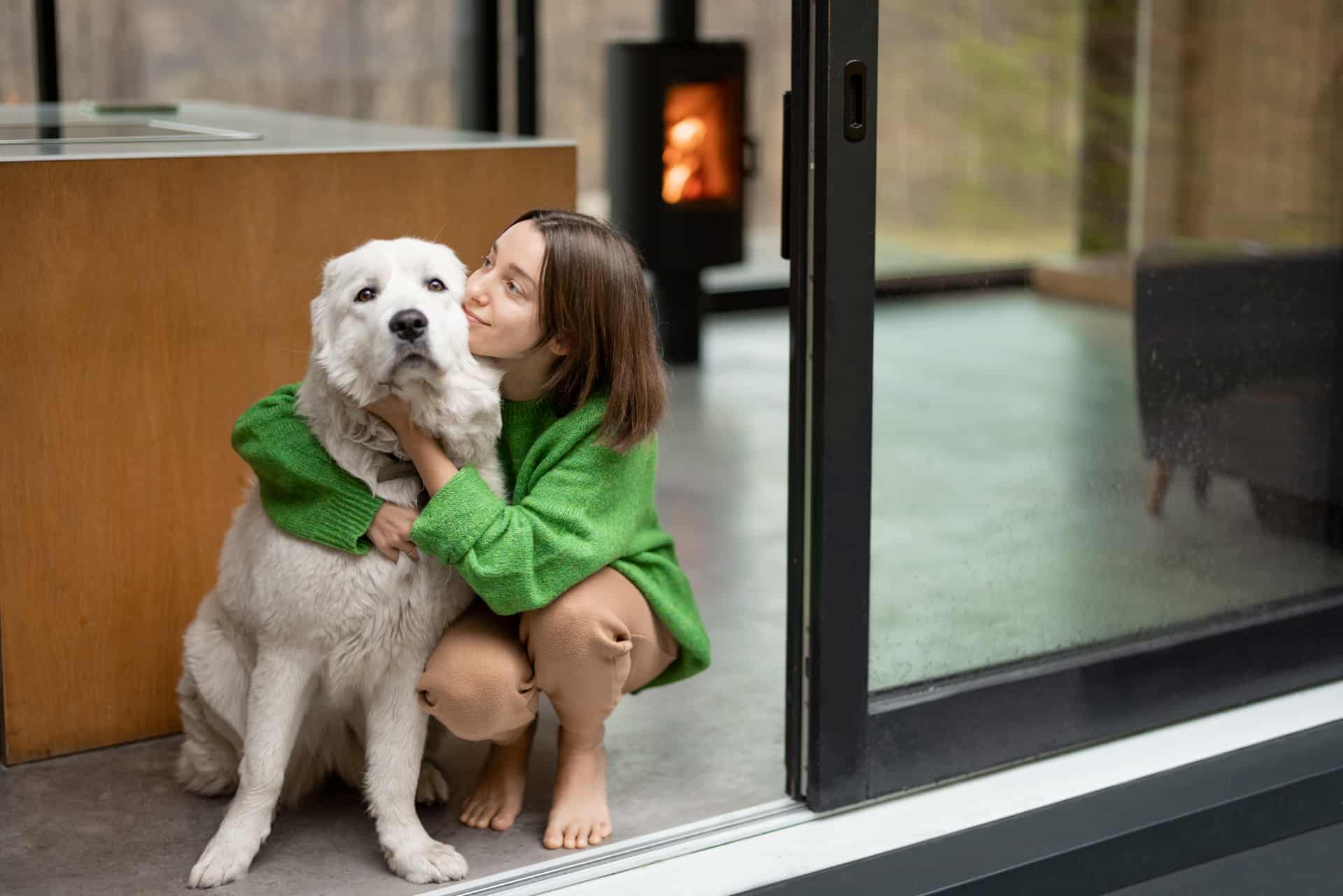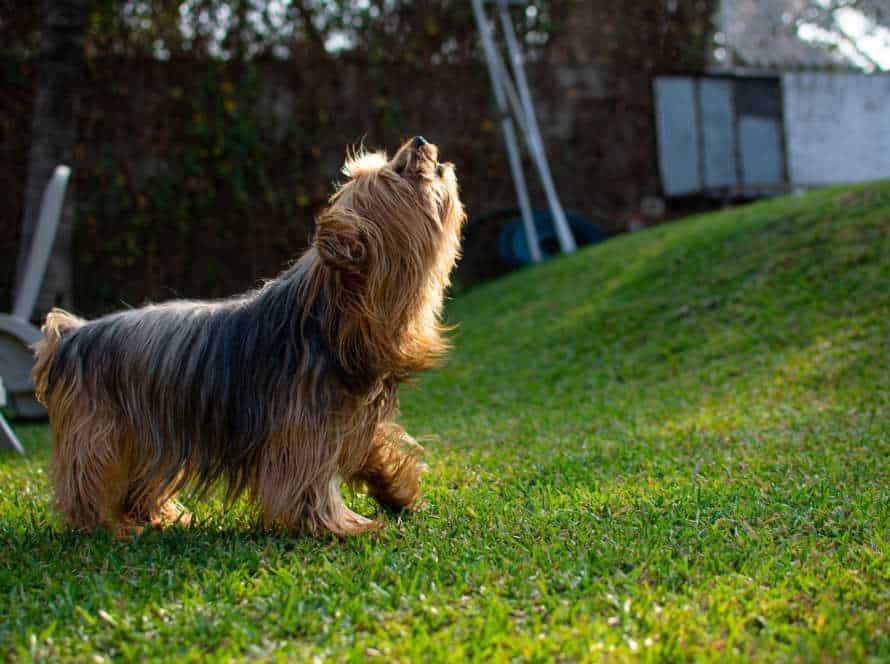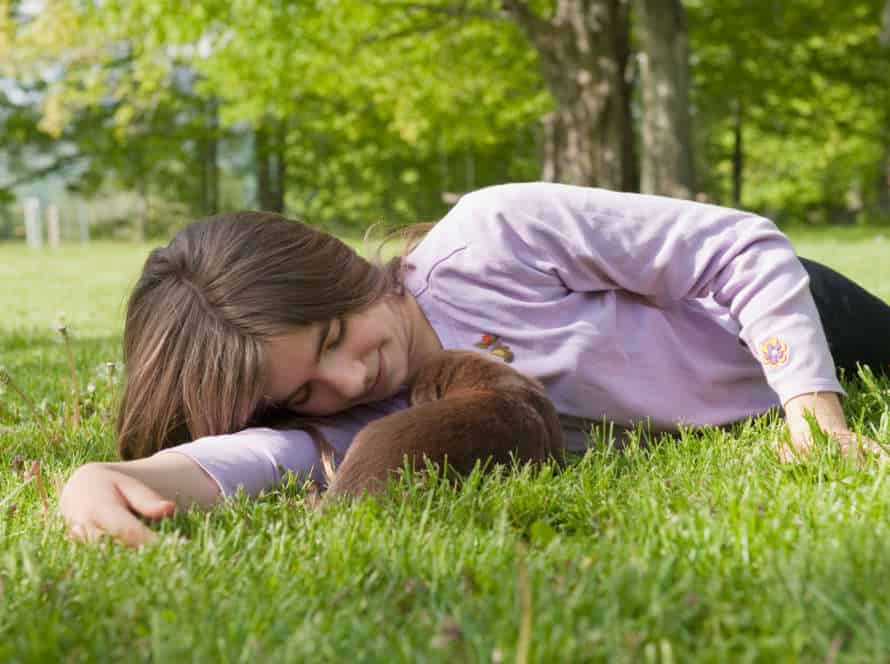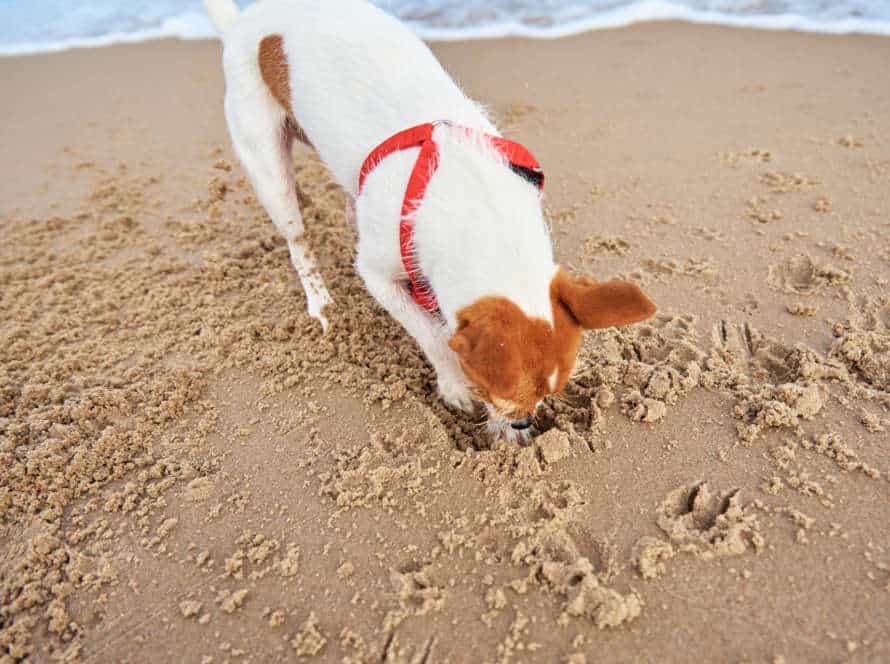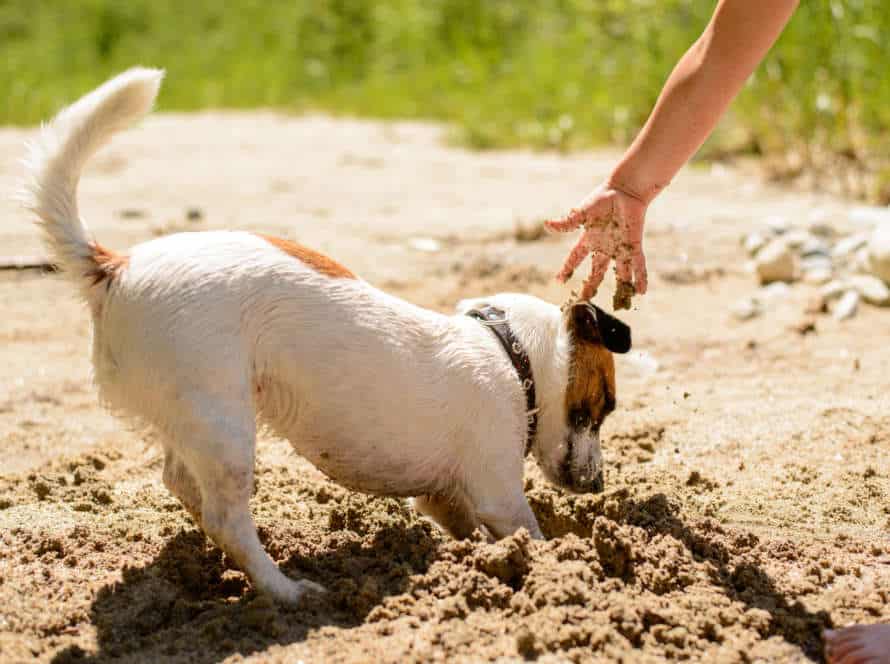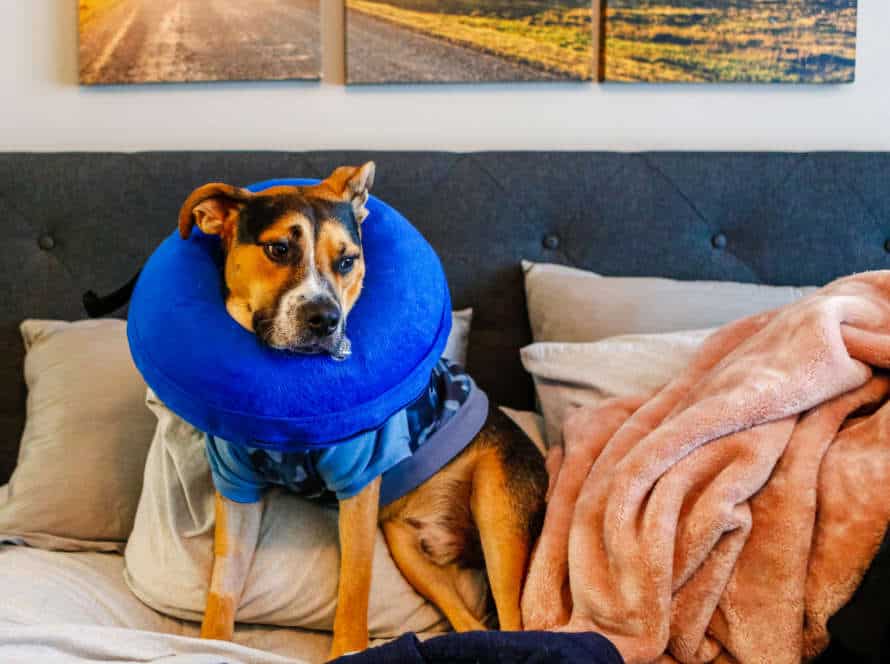How to Desensitize Your Dog to Departure Triggers
Desensitizing your pup to departure cues is key to preventing separation anxiety and destructive behaviour when you go out. Here’s how to do it:
- Start by gradually introducing the triggers. For instance, if picking up your keys sets your dog off, pick them up and put them down multiple times during the day – without leaving the house.
- Then, slowly increase the stimulus. Jangle your keys in front of your doggo or don your coat.
- Make the triggers positive by rewarding your pooch’s calmness. Reward them with treats or praises when they stay relaxed in the presence of the cues.
- Do this consistently, over a few weeks or months, until your pup is no longer anxious around the departure triggers. Be patient, consistent and don’t give up! With effort, your dog can learn to stay chilled when you go out for the day.
Understanding Separation Anxiety in Dogs
Separation anxiety in dogs is often expressed through destructive behaviors. Chewing, barking and whining are some of the signs that your pup is anxious when left alone. To effectively treat it, you must understand why your dog is feeling anxious. Triggers can include clinginess, hiding, barking and restless pacing. To desensitize your pup, you must determine the root cause of the anxiety.
Causes of Separation Anxiety
Separation anxiety in dogs can be due to many things, such as no socialization, changes in the routine, fear, or even a bad experience.
These are some of the possible reasons:
- Unexpected changes in the schedule
- Being left alone for long periods
- A new pet or baby in the house
- Not enough socialization as a puppy
- Abuse or abandonment
Desensitizing your pup to departure triggers, like getting your keys or putting on shoes, try exposing them to these slowly while showing them that you will come back. Start by displaying these triggers without leaving the house, then gradually increase the time away. Praise good behavior and be patient with the process.
Signs of Separation Anxiety in Dogs
Separation anxiety is a difficulty that affects around 20% of dogs. Here are some signs that your pup may be feeling this way:
- Constant barking, howling, or whining when left alone.
- Damaging furniture or digging holes.
- Peeing or pooping inside, even if they are usually housetrained.
- Trying to get out of a crate or room.
- Excessive panting, drooling, or pacing.
To help with this, try leaving for short periods and gradually increase the time away. Also, create a comfy and enjoyable environment for them while you’re gone. Give them treats or toys. In more serious cases, get help from an experienced dog trainer or behaviorist.
The Importance of Desensitization
Desensitization is a way to help pups handle separation anxiety. It exposes them to departure triggers in a secure and ordered atmosphere.
Here is how to desensitize your pup:
- Figure out the triggers that cause fear, like picking up keys or putting on shoes.
- Start with a low-intensity version – like just picking up keys and putting them down again.
- Reward your pup with treats or compliments when relaxed and calm.
- Gradually increase the intensity of the trigger over days or weeks. This will get your pup comfortable with the highest level of the trigger.
- Do this with the other triggers until your pup is desensitized to all.
Pro tip: Be patient, consistent, and always finish the session with a positive note.
Creating a Desensitization Plan
Creating a desensitization plan is vital to ease your pooch’s stress when you are gone.
First, recognize the triggers that cause your pup anxiety. Then, create a desensitization program tailored to your pup’s needs. Here’s how to make an effective desensitization plan:
Identifying Triggers for Your Dog
Identifying triggers for your pup’s anxious behavior when you go away is the first step. Common triggers? Picking up keys, grabbing a purse, turning off lights, saying “bye-bye” or “goodbye”!
Once you’ve spotted the triggers, create a desensitization plan by exposing your dog to the trigger in a positive way. Do this slowly and gradually. Sit down after picking up keys or putting on shoes. Increase the time you spend away from home. Provide your pup with comfort items, like toys and treats. Patience is key. If needed, seek professional help.
Starting Without Triggering Anxiety
Desensitizing your pup to leaving triggers can help reduce their anxiety and make home calmer. Here’s how to create the plan:
- Identify triggers that cause your dog to worry, like jingling keys, clicking shoes, or picking up a purse.
- Desensitize them to the trigger’s presence without actually exiting. Do this by jingling your keys and leaving them on a table.
- Gradually move the trigger closer to where you leave from.
- Practice the last stage by going out of sight, but briefly.
- Strengthen new habits with treats, verbal encouragements.
These steps can help your dog beat separation anxiety and have a happier life.
Gradually Increasing Time and Distance
Desensitizing your pup to leaving triggers calls for a gradual plan to up their tolerance over time and distance. Here’s what to do:
- Identify the triggers that spark anxiety in your dog, e.g. picking up keys or putting on shoes.
- Introduce the trigger at a low level, like jingling keys quietly or putting on shoes and sitting down.
- Reward them with treats and praise for staying calm.
- Gradually increase the duration and intensity of the trigger, like jingling keys louder or standing and going to the door.
- Keep giving rewards for relaxed behavior and slowly raise the time and distance of the trigger until they can cope with your full leaving routine without stress.
Pro tip: Be patient with the desensitization process. Start with small steps and gradually increase intensity, and always reward good behaviour.
Tips for Making Desensitization Successful
Desensitization: A great way to get your pup used to triggers that make them excited, such as people leaving the house. Follow these tips for success!
- Start off slowly, with just a little exposure to the trigger.
- Gradually increase the intensity and duration of the stimulus.
- Praise your pet and reward them for remaining calm.
- Be consistent and patient with the process.
- Avoid punishing your pet if they become upset or overexcited.
- Be sure to take regular breaks and give your pet time to relax and reset.
Positive Reinforcement Training
Positive Reinforcement Training is a great way to lessen your pup’s sensitivity to departure triggers. It works by rewarding desirable behaviors, so they’re more likely to be repeated.
Here are some tips for success:
- Begin with small steps and gradually increase exposure.
- Give treats, toys or verbal praise when your dog is calm and content.
- Train regularly and be consistent.
- Avoid punishment or negative reinforcement – this can make your dog anxious and aggressive.
- Have patience – don’t expect instant results.
By using positive reinforcement techniques, you can create a calmer atmosphere for your pup and reduce their fear and anxiety related to departure triggers.
Consistency and Patience
Desensitizing your pup to “leaving” triggers can be tricky. You need patience and steadiness for success. Here’s how:
- Start small. Get your pooch used to minor things like keys or coat. Then move on to bigger triggers like leaving the house for a bit.
- Keep ’em short. Each session, expose your pup to the trigger for a few seconds or mins then reward for calm behavior. Increase exposure time as pup gets more comfortable.
- Consistency is key. Practice often and stay consistent to give pup a sense of familiarity.
- Patience is a must. Desensitization takes time! Results won’t come right away but with training, positive reinforcement, and persistence, you’ll get there eventually.
Getting Professional Help if Needed
Desensitizing your pup to departure triggers can be tricky and take a while. But, getting help from an expert can ensure you succeed. Here are some tips for getting pro help:
- Research qualified dog trainers near you.
- Schedule a consultation to talk about your pooch’s behaviour and worries.
- Ask for their credentials and experience with desensitization techniques.
- Check their training methods and if they fit with your pup’s personality and temper.
- Get referrals from other pet owners or vets.
- Don’t be shy to ask questions or get a second opinion.
Remember, professional help can give you useful advice to make desensitization a hit for you and Fido!
Lifestyle Changes to Help Combat Separation Anxiety
Make changes to your lifestyle to help your dog with separation anxiety. Desensitize them to triggers like departure. Gradually increase time apart. Create a comfortable and safe space for your dog when you are not around. These slight adjustments can help your pup feel secure and less anxious when you leave.
Exercise and Stimulation
Exercise and stimulation are must-haves for reducing separation anxiety in dogs. Dogs who are both physically and mentally active are unlikely to be anxious when left alone.
So, let’s incorporate exercise and stimulation into the daily routine!
- Walk, run or play with your pup.
- Give them puzzle toys, interactive toys, or train them.
- Help them get used to leaving triggers. For example, keys and shoes. Practice when your pup isn’t expecting to leave.
- Think about hiring a dog walker or pet sitter. They can provide companionship and exercise while you’re away.
By making these lifestyle changes, your pup will be calmer, happier and less likely to suffer from separation anxiety.
Regular and Predictable Schedule
A regular, predictable schedule is great for your pup’s well-being. Dogs love routine and knowing what to expect. Here’s how to set up a schedule:
- Feed ’em at the same time daily.
- Walk or exercise them at the same time everyday.
- Create a plan when coming and going from home.
- Slowly increase the amount of time away from home so they get used to it.
- Be consistent and patient when training. Every dog is different. It may take a few tries to get the right routine.
Alternatives to Leaving Your Dog Alone
Leaving your pup on their lonesome for too long can cause Separation Anxiety. Signs of this are: too much barking, destructive chewing, and peeing in the house. Here are three things to do to help lower the severity of your dog’s Separation Anxiety:
- Start a steady routine of coming and going. Desensitize your pup to you leaving by doing the same thing every time. Begin with little bits of time and gradually increase until your pup is comfy being alone.
- Hire a dog walker or pet sitter. If you can’t take your pup with you when you leave, get a dog walker or pet sitter to give them company and stimulation.
- Think about doggy daycare. If your pup is very social and loves being around other dogs, you could enroll them in doggy daycare. There, they can play with other dogs and be supervised. This will help your pup use up energy and reduce stress.
These changes can really help with reducing Separation Anxiety, and make a happier life for you and your pup!
Conclusion: Helping Your Dog Overcome Separation Anxiety with Desensitization
Desensitization is a great way to help your pup get over separation anxiety. By training your pup to be comfortable with your departure triggers, they will learn to link your absence with pleasant experiences. Here are the steps:
- Spot your pet’s departure triggers
- Make a desensitization plan, starting with the least demanding trigger and work up to the most difficult one
- Link departure triggers with rewards, like treats and playtime
- Increase the time and force of each trigger, raise your pup’s assurance and ease
- Be patient, consistent, and supportive, reward your pup for their progress and give reassurance when they find it tough. With commitment and patience, desensitization can make your pup more settled and sure when you’re not home.
Frequently Asked Questions
1. What are some common departure triggers that can cause anxiety in dogs?
Some common departure triggers include putting on shoes, picking up keys, grabbing a purse or briefcase, or even simply putting on a coat or jacket.
2. How can I desensitize my dog to these departure triggers?
Desensitizing your dog involves gradually exposing them to the triggers in a controlled and positive way. For example, you can pick up your keys and then immediately put them back down, followed by giving your dog a treat. Over time, you can increase the duration of holding the keys and leaving the room, always pairing it with a reward.
3. How long does it take to desensitize a dog to departure triggers?
The timeline for desensitizing a dog can vary depending on the individual dog and the severity of their anxiety. It may take several weeks or even months to fully desensitize your dog to a particular trigger.
4. Can medication be used to help desensitize a dog to departure triggers?
Medication can be used in conjunction with behavior modification techniques to help reduce a dog’s anxiety. However, it is important to consult with a veterinarian to determine the appropriate medication and dosage for your dog.
5. What other techniques can I use to help my dog with separation anxiety?
Other techniques to help alleviate separation anxiety in dogs include creating a comfortable and safe environment, providing plenty of exercise and mental stimulation, and gradually increasing the amount of time your dog is left alone.
6. Should I seek professional help for my dog’s separation anxiety?
If your dog’s separation anxiety is severe or not improving with behavior modification techniques, it is recommended to seek the help of a professional dog trainer or behaviorist. They can provide additional guidance and support to help your dog overcome their anxiety.

